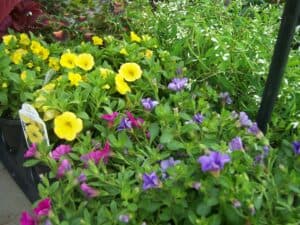
By Jennifer Fairfield, owner of Garden Mill
As the weather cools off, it’s a great time to fill in bare spots in the lawn.
To fill in your lawn’s bare patches, start by raking away any dead grass and roots, and then sprinkle some seed in. You can also add a little bit of top soil to give the seed a better chance to take hold. Don’t forget to cover the area lightly with a little mulch (straw works well) to keep moisture in.
Keep the area well-watered. Once the grass starts to emerge, remove the mulch so as not to smother the grass.
De-thatch your lawn, if necessary. This is something that most people don’t do, and probably should, if they want a really good looking lawn. According to the MSU extension, “Thatch is the accumulation of dead and decomposing turf stems, leaves and roots intermixed with live plant roots.” It’s not due to leaving clippings on the lawn as sometimes is believed. Leaving clippings is actually really good for your lawn. Some thatch is also good, but too much is not.
MSU has a good resource on what thatch is and why it’s a problem (it was written in 2012, which had very similar summer weather conditions to what we experienced this year). The Virginia Cooperative Extension offers information on how to de-thatch your lawn.
My recommendation is to wait to do this until we are well into cooler temps and maybe have gotten a little more rain – those conditions will help your lawn recuperate from the de-thatching process, which can put a little stress on it, but can be worth it in the end.
Fertilize your lawn in the early fall (mid-September is generally a good time), to encourage good root growth before winter.
Continue to mow, but don’t cut it too low. Your grass needs a little bit of height to help insulate the roots during the winter, but don’t stop mowing and leave it too long either. This will promote something called snow mold disease, which will leave ugly bare patches in your lawn next spring.
Rake up the leaves that fall. Leaves left lying on the lawn can also promote snow mold disease, so rake them up and use them as mulch or add them to your compost pile. If you are going to do either, it’s best to chop them up a bit, as whole leaves tend to mat down and suffocate either the plants you are mulching or your compost. Both need air. You can chop them up rather easily by raking them into piles and running over the piles with the mower (which will cause you to have to rake them up a bit again, but strategic running over with the mower can minimize this).
Vegetable Garden
It’s not too late to get in a last planting of some things in the veggie garden, like fast-growing baby leaf lettuces and radishes. But do it by this weekend, so that they have time to produce before we starting getting frost. If we get some early light frosts at the end of the month, just cover them with row covers to keep them going longer.
You can also plant things like spinach and kale, but you will definitely need to keep row covers handy (or plant them in a cold frame) as we head into October. Kale can take some pretty good frosts, but only if it is already pretty mature at the time. If you are planting it now, you will need to give it some help against frost until it is well established. Spinach is less frost-hardy, so will need protection to continue producing once we start seeing frost – usually by early October.
Keep picking what you have. I am still getting lots of beans, tomatoes, and peppers, along with herbs. Most herbs can be chopped up and frozen for “fresh” herbs all winter long. I wash and dry them thoroughly, then chop them and put them into zipper bags, squeezing out all the air before putting them into the freezer. This doesn’t work well for basil though, so my favorite thing to do with all the basil in my garden as the cold weather sets in is to make lots of pesto and put it into ice cube trays and freeze it. Then I have “fresh” pesto all winter. Cover the pesto with a thin film of olive oil before freezing it to keep it from discoloring.
Drying your herbs is also a good way to preserve them. Simply hang them upside down in a dry area until they are completely dry. Then strip the leaves off and store them in a zipper bag or other airtight container.
Toward the middle or end of the month, consider sowing spinach seeds in your garden for harvest next spring. Spinach will overwinter and treat you to an early crop as spring warms up.
If you still have tomato plants going strong in your garden, it’s a good idea to pinch off new flowers at this time (this goes for peppers and eggplant, too). This allows the plant to work on maturing the fruit that’s already on the vine before frost sets in, rather than working on producing more fruit that won’t have time to ripen. Of course, if you like green tomatoes for frying or canning, then by all means, skip this step.
Keep an eye out for pests in your garden still – they won’t generally go away until the weather changes, and if you want to get the most out of your garden, you want to keep them under control. I have had one heck of a time with caterpillars eating my kale. I have yet to actually eat any of the kale from my garden because they keep getting to it first.
There are two types of caterpillars that munch on everything in the family of cole crops (kale, cabbage, broccoli, Brussels sprouts, etc.). One is the European cabbage moth worm, and the other is the cross striped cabbage worm. I have been fighting both of them all summer, and they have been winning. But, I am determined not to give up – I love kale, and want to get at least some out of my garden this year. So, I have picked up my game with them – I’m scouting my plants more frequently, and picking them off and squishing them whenever I find them. That can be challenging, especially with the cabbage worms, as they blend really well with the green of the kale.
If you are growing winter squash, keep spraying with an organic fungicide all the way up to harvest. You will want to cover these plants up if we get any frost before the fruits are ripe – even though they are called winter squash, they don’t do well with frost.
(Part two will publish tomorrow.)


















